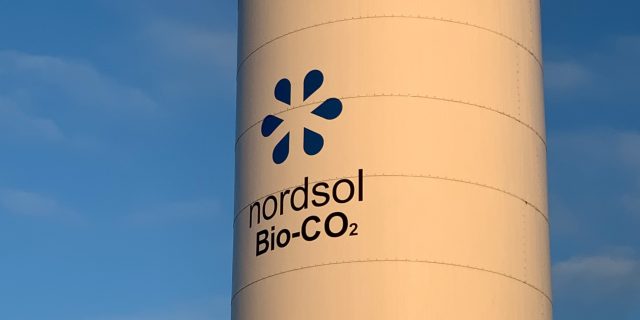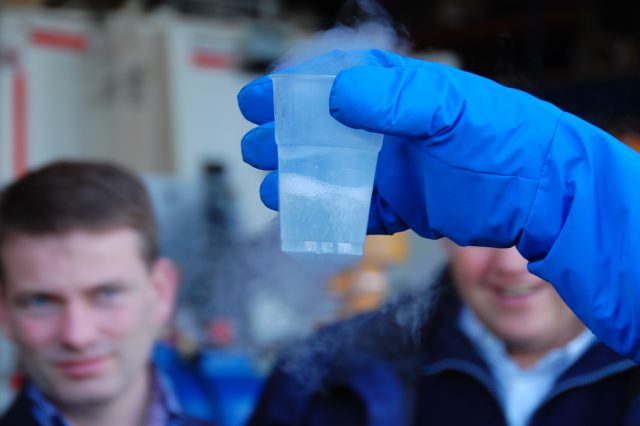The next step in energy-efficient production of bio-LNG
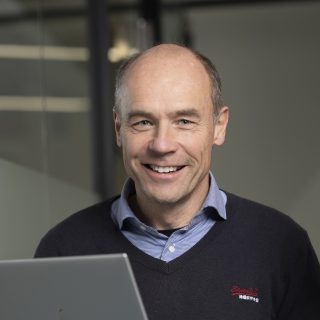
Nordsol’s iLNG process in 10 questions (and answers)
Sep 15 2023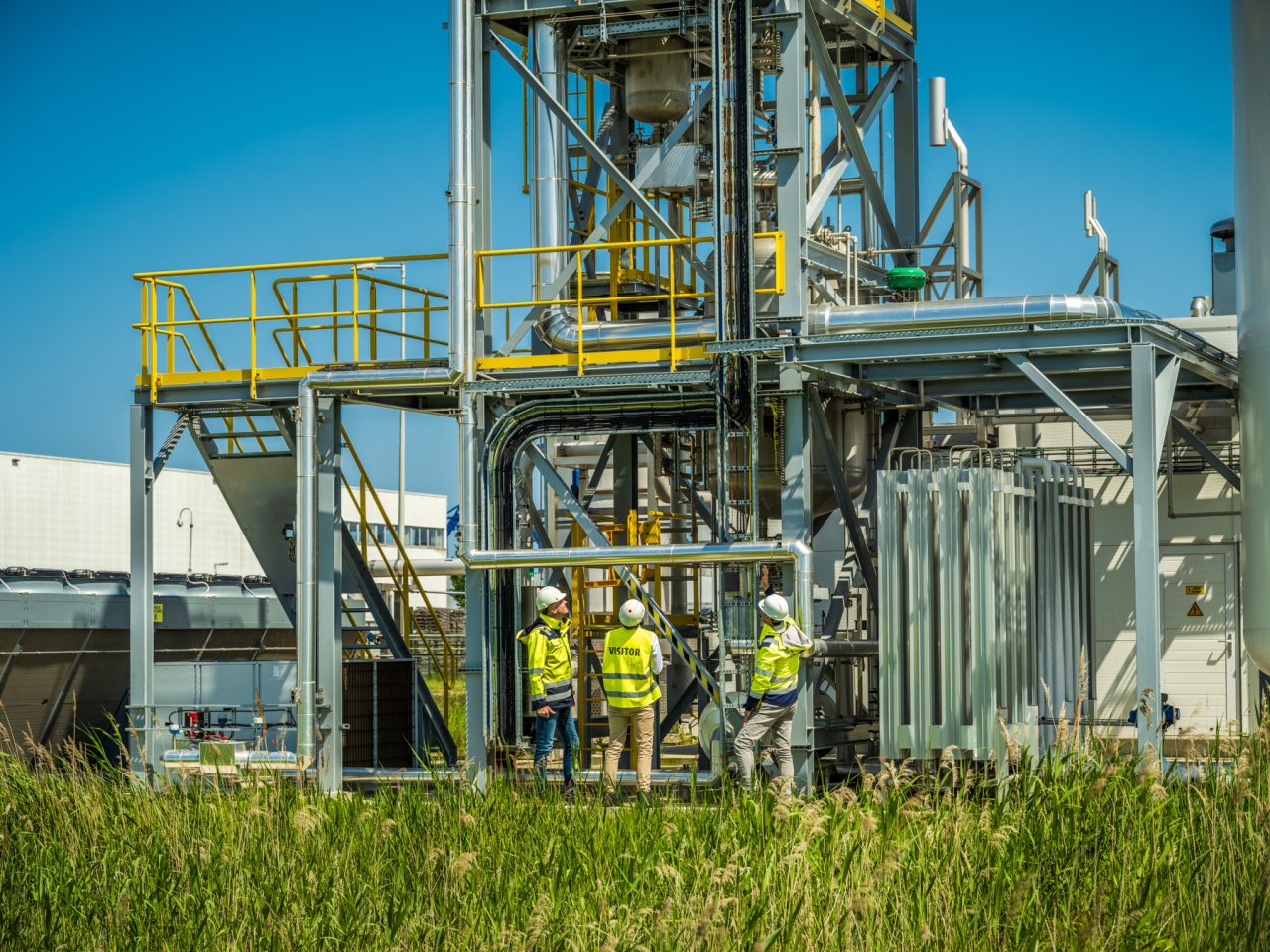
Energy consumption is a critical aspect of bio-LNG production. Not only does it determine a significant part of the operational costs, it also has an impact on the carbon intensity of the biofuel and therefore its economic and ecological value. This Q&A provides several insights into how Nordsol’s distinctive iLNG process design is optimized for low energy consumption in small-scale bio-LNG production from biogas.
Companies that manufacture process equipment usually focus on either gas treatment or liquefaction since these are two very distinct technologies. Teams of EPC companies, system integrators, experts and consultants bring all components together, match unit interfaces, supply utilities and deal with authorities (permits), draft contracts with bio-LNG off-takers, arrange carbon intensity certification, etc. Operators are trained by specialized companies. And again other companies own and operate the facility.
However, for the energy consumption and operability of a bio-LNG production facility, the selection of process technology and equipment is decisive. That is why Nordsol has taken an entirely different approach, and we’ve put the interests of the operator and asset owner first.
We have developed and designed a new process and applied this in the first bio-LNG plant in the Netherlands that we own and operate ourselves. In particular, the design of the innovative process line-up and selection of equipment played a key role in reaching a very low energy consumption. Nordsol has been able to completely integrate biogas treatment and liquefaction, which gives significant operational benefits. The process is safe, reliable, efficient, very user-friendly and unmanned.
As a technology leader with our own installation, we know what is important when designing, owning, operating and maintaining a bio-LNG facility.
Nordsol technology is unique since it only uses membranes for both bulk- as well as trace-removal of CO₂, water and even H₂ from biogas. Membrane gas separation is a continuous and energy-efficient process without heat nor chemicals nor waste streams. However, the downside of standard membrane gas separation is that these cannot perform the trace removal of impurities down to the very low concentrations necessary for the liquefaction of methane. This limitation has been resolved in Nordsol’s proprietary iLNG process.
Traditional technologies in the LNG industry typically use liquid absorbents like amines and solid adsorbents like molecular sieves. These “unit operations” require regeneration steps (heat at high temperature), cooling, chemicals and produce waste streams (contaminated water), produce waste heat and need a significant number of equipment. Additionally, adsorption processes (molecular sieves) are not continuous, and frequent switching between adsorption and regeneration modes causes fluctuations in gas flow and temperature.
Nordsol has developed the patented “flash-to-sweep” concept, which boosts the performance of the membranes by sweeping (flushing) the low-pressure permeate side of the membrane with flash gas from the liquefaction unit.

Sweeping the permeate side of membranes is very common in applications like gas drying. However, the use of flash gas as sweep gas is an innovative approach, which allows for the removal of both CO₂, water and even hydrogen down to very low concentrations in a simple single step, or so-called “unit operation”.
This energy-efficient gas treatment method is unique within the LNG industry. All LNG facilities in the world, both large and very small scale, apply the combination of amine CO₂ absorption, followed by (in series) gas dehydration by molecular sieves (Temperature Swing Adsorption – TSA).
LNG peak shaving facilities and some bio-LNG plants which are equipped with CO₂ bulk removal by membranes, use molecular sieves for combined CO₂ and water trace removal (polishing). Although limited to few % CO₂, this has many advantages compared to amine gas treating. In case of combined CO₂ and water removal by molecular sieves, the regeneration gas is returned to the biogas compressor or injected into the gas grid (LNG peak shavers). Thereby the need for amine scrubbing required for deep CO₂ removal is eliminated. However, the combined CO₂-water removal by molecular sieves requires frequent mode switching (cycles) and is not efficient because of a relatively high regeneration gas flow (recycle). Alternatives like regeneration with hot air, have significant downsides.
Moreover, technology and equipment suppliers do generally not integrate different, potentially competing technologies into the process. Gas treating and liquefaction technologies are commercially kept entirely separate to allow different combinations of technologies and only a few companies can design and offer both technologies, nicely integrated in one plant.
As an LNG technology integrator, Nordsol seized this opportunity, patented its iLNG process lineup, and tested the “flash to sweep” concept with various standard, off-the-shelve 4-port membranes. The flash-to-sweep concept reduces the CO₂ concentration in the retentate of the membrane by a factor of more than 200; e.g. from 4 mol% to 200 ppm. Without the sweep gas, the reduction of CO₂ concentration in the retentate would be only factor 10. The resulting integrated process is simple to operate, produces on-spec gas instantly after start-up, is continuous, waste-free, and energy-efficient.
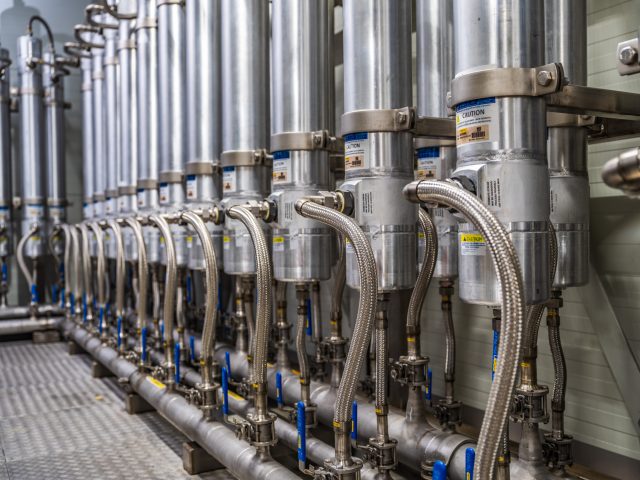
Because of the continuous nature of the membrane gas separation process, the biogas feed flow to the facility is extremely constant with deviations of <1% around the capacity (biogas flow) setpoint. This is a unique and critical feature since a biogas buffer between digester and bio-LNG plant is usually not present or very limited. Unwanted variations of biogas flow to the bio-LNG unit by for example a mode-switching TSA unit, can easily result in frequent flaring of some biogas
To liquefy the biomethane, its temperature must drop to -145°C or lower. There are several refrigeration technologies that can do this, each with their own operational challenges, efficiency and complexity. The Linde cooling cycle, developed by Carl von Linde in 1895, is a simple refrigeration technology that employs gas expansion through a throttling valve. While easy to implement, its efficiency is low and inherently limited due to the fundamental laws of thermodynamics. Still, the Linde refrigeration cycle is widely used in cryogenic industries and the bio-LNG industry in particular.
To approach a theoretically perfect thermodynamic process, a highly complex and costly installation is necessary. The following basic refrigeration cycles for (bio-)LNG can be distinguished, listed in increasing order of complexity and energy efficiency.
- Liquid nitrogen (LIN) open-cycle
- Stirling cycle
- Linde cycle
- Reverse Brayton cycle
- Mixed Refrigerant (MR) cycle
- Cascade, mixed fluid or pure component cycles
There are many variants and permutations of these processes, but they can all be categorized according to the six groups mentioned above.
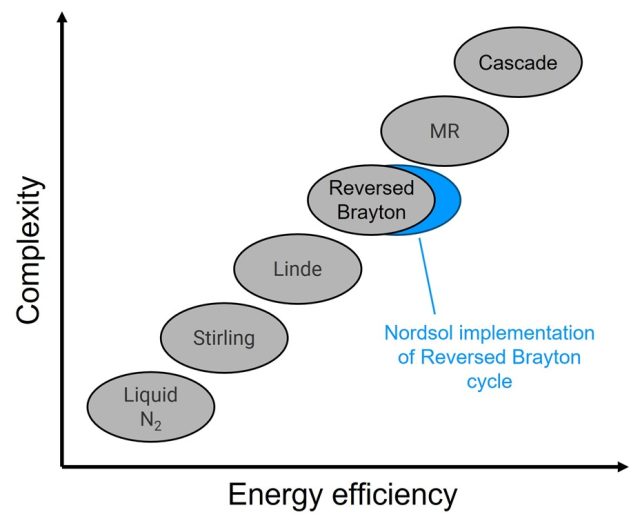
Nordsol has designed its process based on the reverse Brayton cycle, which is a good compromise between efficiency and complexity. Nordsol uses methane derived from the biogas as the ‘working fluid’ or refrigerant, which makes it the most efficient reverse Brayton cycle in the required temperature range. Only a few kilos of methane vapor are present in the closed refrigerant cycle. The chosen technology combines the best of two worlds: low equipment count, low refrigerant inventory (safety), easy to operate, while maintaining a relatively high efficiency.
The reverse Brayton cycle technology is, in fact, already in use for the re-liquefaction of Boil Off Gas (BOG) on LNG ships. However, the challenge with the reverse Brayton cycle lies in incorporating an efficient and reliable high-speed turbo expander, which functions as the core of the liquefaction system. Air Liquide’s Turbo Brayton system is a compact and efficient liquefaction system based on nitrogen as the refrigerant with a turbo expander equipped with very robust but relatively complex and costly magnetic bearings.
Nordsol, in collaboration with equipment supplier, has successfully integrated a methane turbo expander in the bio LNG process. The machine running at 60,000 rpm is derived from so-called air cycle (air conditioning) machines in commercial aircraft, like Boeing 777. These Air Cycle Machines (ACM) operate on air and are very reliable, robust, capable to perform 1000’s of start-stops and based on ‘simple’, robust gas foil bearings.
The unique Nordsol application of the turbo expander, equipped with foil bearings and with methane as the refrigerant, further improves the simplicity and efficiency of the reverse Brayton cycle process in the required temperature range, compared to the nitrogen expander. The methane turbo expander with foil bearings is currently running at a high efficiency, reliably, 24/7 at Nordsol’s bio-LNG plant in Amsterdam.
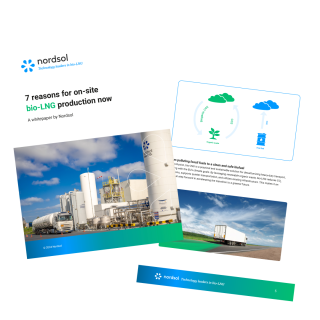
Learn how biogas producers significantly enhance both the ecological and economic value of their biogas through bio-LNG production, utilizing Nordsol’s innovative biogas liquefaction technology.
Fundamental thermodynamic principles dictate that it is not feasible to achieve such efficiency with the LIN(1), Stirling (2) and Linde (3) cycles. These consume about 25-75% more electrical power compared to the reverse Brayton (4) cycle. Highly efficient but complex technologies, such as Mixed Refrigerant (5) and Cascade (6) cycles, are typically only applied on a large- and mid-scale due to their high cost and operational challenges, including controlling the inventory (pressure, liquid levels) and composition of mixed refrigerant ‘cocktail’.
The efficiency of all these technologies can be enhanced through the addition of pre-cooling. This is a common practice at LNG plants with propane being the most common refrigerant for pre-cooling. In the case of a pre-cooled Linde process, temperatures are typically reduced to -30°C upstream of the Linde cycle. This slightly improves the overall efficiency of the Linde cycle, but similar improvements are achieved with other technologies. Nordsol’s reverse Brayton methane cycle process also employs ‘moderate’ pre-cooling to -7°C, which is supplied by a reliable, low-cost and efficient industry-standard chiller unit.
Bio-LNG production from biogas is a very small-scale process that, in addition to energy efficiency, requires cost efficiency, a compact installation, and an easy to control, preferably unmanned process.
While Mixed Refrigerant and Cascade processes are inherently more energy efficient than a reverse Brayton cycle, they are complex to design, build, and operate. In addition, these processes require the import and storage of refrigerants such as ethane, propane, and butane. Moreover, to achieve a low energy consumption, these processes require a significant amount of cryogenic equipment. Controlling factors such as the exact composition of the ‘cocktail’ of the mixed refrigerant is also crucial for a high efficiency. However, this can be difficult to manage and requires the storage of flammable, pressurized liquid refrigerants like ethane and propane.
The reverse Brayton cycle provides a more suitable solution for smaller-scale bio-LNG facilities due to its relative simplicity and high efficiency. As mentioned earlier, Nordsol uses treated biomethane as the refrigerant in the closed cycle. Methane is thermodynamically the most efficient refrigerant for the reverse Brayton process in the temperature range of -50°C to -120°C. To decrease the temperature of the liquid biomethane product below -150°C, the Nordsol process uses flash cooling. And the low pressure flash gas is used again as the sweep gas in the membranes.
The Nordsol reverse Brayton cycle is based on methane gas expansion through a single turbo expander and is a simplified version of the efficient AP-C1 process developed by Air Products, which employs dual methane turbo expanders. Air Products, a global market leader in LNG, has demonstrated through their whitepaper that gas expansion cycles with flash cooling can provide significant power savings and has other important advantages. Gas expansion with flash cooling offers specific advantages compared to sub-cooling.
Reduced risk of freeze-out
Sub-cooling to a low temperature (less than -150°C) in a heat exchanger carries the risk of local freeze-out during transients and brief upsets (e.g. increased CO₂ concentrations). This risk is significantly reduced in a gas expansion – flash cooling process with a relatively high temperature (-120°C) of the heat exchanger.
Smooth cooldown
Cold shocks are very common with liquid LNG or liquid Mixed Refrigerant (MR) in heat exchangers. Longer-term, they can result in leaks in heat exchangers due to thermal fatigue. Since there are no liquids in the heat exchanger in the iLNG process, there is no risk of cold shocks, no liquid mal-distribution (unbalanced cooling) nor any risk of thermal fatigue.
Integration with Boil-Off Gas
Low-pressure flash gas, combined with BOG from the tank and return gas from truck loading, serves as the sweep gas for the membranes in the biogas treatment step. The gas is recycled to the biogas compressor, which now combines several functions into one efficient machine: biogas compressor as well as BOG, flash gas, and truck return gas compressor.
Simplified startup procedure
During the startup, sub-cooling is initially not possible since there is no liquid. The cooldown procedure of a gas expansion – flash process is much easier and fast, with the option to recycle a relatively large flow of flash gas during a steady, well-controlled equipment cooldown.
The iLNG process was applied for the first time at a commercial scale in Nordsol’s bio-LNG plant in Amsterdam Westpoort. In this installation, 900 Nm3/hr biogas is efficiently and reliably converted to 10 tons per day bio-LNG and 15 tons per day of biogenic liquid CO2. The plant was opened in October 2021 and can now run at 110% of design capacity.
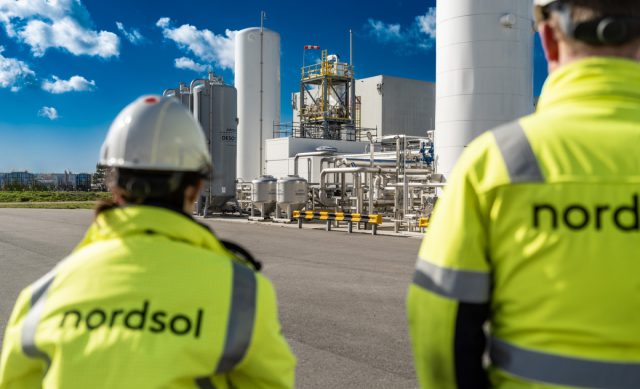
The first six months of operation were used to solve several challenging but common technical problems that arise when adopting a new technology. Most challenges were related to unstable flow dynamics, trip transients, vibrations and mechanical issues. After this period resulting in some control and hardware modifications, the plant operates efficiently and reliably, 24/7, and most of the time unmanned. The detailed process simulation model in Unisim was the basis for all equipment design and shows a very close match with actual plant operation.
In the fall of 2022, the technology and the process were optimized to further increase energy efficiency and production capacity. Energy consumption for the entire process from raw biogas to ready-to-use bio-LNG is between 1.3 and 1.4 kWh/kg bio-LNG, which is very low. The process only uses electrical energy, no heat, no consumables and has no vent nor waste streams.
The plant in Amsterdam also produces liquid CO2 which is present in the biogas. By liquefying the separated biogenic CO2 and reusing this in greenhouses or industry, the carbon intensity of the produced bio-LNG decreases significantly and the overall value is increased.
The practical experience with the plant in Amsterdam has taught us that the integrated iLNG process for biogas treatment and liquefaction is economically attractive between 500 – 6000 Nm3/hr raw biogas, thanks to a competitive CAPEX and low energy costs.
Many companies are considering and already developing the production of synthetic methane (also called e-methane, or Power-to-X) from green hydrogen, produced from temporary excess, low-cost renewable electricity, and biogenic CO2 present in biogas. One of the challenges with the production process is that the methanation reaction, which produces synthetic methane from CO2 and hydrogen, always leaves some hydrogen in the methane product stream.
Membrane gas separation is the most efficient non-cryogenic gas-treating technology that separates hydrogen from methane. Amine absorption and TPSA (Temperature, Pressure Swing Adsorption – molecular sieves) do not remove any hydrogen from methane. This makes the Nordsol flash-to-sweep concept a unique and the most efficient gas-treating process to handle a gas mixture of biomethane, synthetic methane, CO2, and traces of hydrogen and water vapor. All impurities, including hydrogen, are removed via the flash-to-sweep membranes and returned to the biogas compressor and from there to the membranes and methanation reaction. The retentate from the flash-to-sweep membranes consists of a mixture of biomethane and synthetically produced methane, is extremely pure and ready for liquefaction.
Nordsol works on a fully integrated process to include biochemical methanation (Power-to-X), as developed by other companies, into the ‘core’ iLNG process line-up. There are absolutely no waste- nor vent streams from the process.
Last but not least: biogas production combined with ex-situ biomethanation (outside digester) and the storage of both bio-LNG and biogenic LCO2 provide a significant local buffer (battery) to perform grid balancing. From maximum to low electrical power consumption or even the export of power is possible. And this fast ‘mode switching’ is entirely based on increasingly varying (volatile) electricity prices. Energy from biogas is complementary to PV and wind power because the energy can be stored locally as bio-LNG.
This is so-called ‘sector coupling’: green electrical power and a low carbon fuel can be produced and stored efficiently on one site. The ratio between power and fuel can be adjusted while following local grid congestion and fast-changing market prices.

business opportunity.
Want to know if producing bio-LNG out of your biogas is profitable?
Let's explore together. Take our quick scan or contact Niels now.
